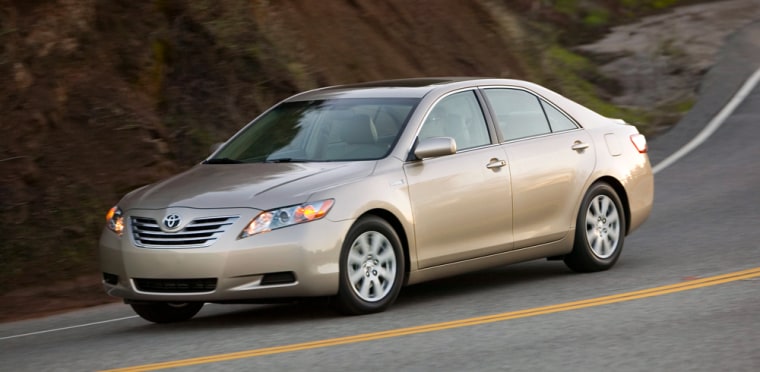For the first time ever, America’s top-selling car, the Toyota Camry, comes as a fuel-thrifty gasoline-electric hybrid.
It’s big news for the Camry, which was redesigned, made larger and more powerful for 2007.
The new, 2007 Camry Hybrid looks like a regular four-door, five-passenger Camry sedan.
And with seven standard air bags, including a new, knee air bag to help keep the driver in proper seat position during a frontal crash, the Hybrid gets the same, top, five-out-of-five-stars safety rating for front and side crash protection as do all new 2007 Camrys.
But the hybrid also has a quieter interior, a nifty hybrid power graphic on a dashboard display screen, and the highest government fuel economy rating of any Camry — 40 miles a gallon in city driving and 38 mpg on the highway as its supplemental electric power boosts around-town travel most of all.
$6,600 more than gas sibling
Starting manufacturer’s suggested retail price, including destination charge, is high for this model. It’s $26,480 and includes a continuously variable transmission (CVT) that a driver operates like an automatic, plus some uplevel amenities such as eight-way, power driver’s seat.
This compares with a starting price of $19,900 for a base Camry CE with four-cylinder engine, automatic transmission and six-way, manual driver’s seat and $23,920 for the lowest-priced Camry with V-6 and automatic.
The Camry Hybrid does, however, qualify for a federal income tax credit of up to $2,600, though this amount is halved and then halved again once certain sales volumes of Toyota hybrids are reached. Buyers should check with dealers and the Internal Revenue Service for details.
One of only five cars with gas-electric hybrid power sold in the United States at the start of the 2007 model year, the Camry Hybrid competes primarily against the other five-passenger, mid-size hybrids. They are the 2007 Toyota Prius, which starts at $22,755, and the Honda Accord Hybrid sedan, whose pricing for 2007 has not yet been announced. In the 2006 model year, the Accord Hybrid started at $31,540.
The Prius, which has a five-door hatchback design and a combined 110 horsepower from its gas-electric system, serves up more mileage than the 187-horsepower Camry Hybrid. Government fuel economy ratings for the Prius are 60/51 mpg.
250 horsepower, smaller trunk
The Accord Hybrid, which comes with a V-6 mated to an electric power plant, has a 28/35-mpg rating and is tuned for performance and more than 250 horsepower, rather than strictly fuel mileage.
At 3,680 pounds, which is more than either the lighter-weight Prius or the Accord, the Camry Hybrid feels and looks like a substantial car. The outer styling, as in other 2007 Camrys, is reminiscent of Toyota’s luxury Lexus brand. Inside, it has new features, easy-to-operate buttons and knobs and more rear seat, leg and shoulder room than the Prius and Accord Hybrid.
It’s true that in trunk space, the Camry Hybrid loses nearly 4.6 cubic feet compared with a gasoline-only Camry. This is because a battery pack for the electric motor system sits behind the hybrid’s rear seats, reducing trunk space to 10.6 cubic feet.
In comparison, the Prius has 14.4 cubic feet in storage space and the Accord Hybrid has 11.2 cubic feet.
But the most noticeable difference comes in the driving.
The Camry Hybrid has a mostly refined, quiet sense from the minute the standard push-button start is pressed.
At times, I didn’t know the test car was on, because the 2.4-liter, double overhead cam, inline four cylinder didn’t immediately start up. In fact, I could back out my driveway and head down my neighborhood street at moderate speeds on quiet, electric power only.
But watch carefully for pedestrians. They’re accustomed to hearing vehicle engine noises and may not notice a Camry Hybrid coming up from behind.
There were hot summer days when the Hybrid’s four-cylinder engine came on almost immediately at startup. This was because I wanted to get the air conditioning going full blast, and it won’t operate this way on electric power only.
Also, on some particularly oppressive, 90-degree days, it was not unusual to hear a fan whirring behind the Camry Hybrid’s back seats when I started the car without the air conditioning on. This fan kept the battery pack cool and operated on its own.
Normal feel
For the most part, I didn’t know I was driving a hybrid. The Camry Hybrid uses Toyota’s latest Hybrid Synergy Drive system and has electronics that automatically mixes the gas engine power with electric power, as needed.
Save for the intriguing dashboard graphic that showed where the power was coming from — engine or electric source — and a sometimes golf cart feel with just the electric power on, the Camry Hybrid felt like a “normal” sedan.
The engine can generate 147 horsepower on its own, so highway travel isn’t sluggish.
In city traffic and during passing maneuvers, electric power provided good get up and go. The car’s 105-kilowatt electric motor can produce 199 foot-pounds of torque instantly for smooth, quick acceleration.
Best of all, in actual city/highway driving — and without concern for fuel mileage, I admit — the test Camry Hybrid got 36.4 mpg, or just 6.7 percent less than what the window sticker advertised. This was with the air conditioning on, too.
The ride was pleasant. The car rolled over most bumps without fuss, and I was able to talk with passengers in the quiet interior.
More than 17,300 Camry Hybrids have been sold so far this year.
